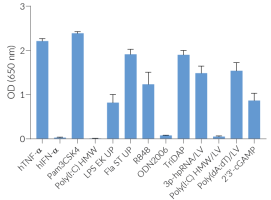THP1-Dual KO-IFI16 Cells
-
Cat.code:
thpd-koifi16
- Documents
ABOUT
IFI16 knockout dual reporter monocytes
THP1-Dual™ KO-IFI16 cells were generated from THP1-Dual™ cells by stable knockout of the IFI16 (Interferon-γ-inducible protein 16) gene. IFI16 is an innate immune sensor with multiple functions; DNA sensor, regulator of interferon (IFN) expression, activator of the inflammasome, and regulator of genome function [1,2]. These cell lines were derived from human THP‑1 monocytes, a cell line often used to study DNA sensing pathways as they express all the cytosolic DNA sensors identified so far (with the exception of DAI).
THP1-Dual™ and THP1-Dual™ KO-IFI16 cells stably express two inducible secreted reporter genes: IFN-inducible Lucia luciferase and NF‑κB-inducible SEAP (secreted embryonic alkaline phosphatase). They can be used to study the role of IFI16 by monitoring IRF-induced Lucia luciferase activity, using QUANTI‑Luc™, a Lucia™ luciferase detection reagent.
THP1-Dual™ KO-IFI16 cells are resistant to the selectable markers blasticidin and Zeocin®.
References:
1. Jakobsen MR. & Paludan SR., 2014. IFI16: At the interphase between innate DNA sensing and genome regulation. Cytokine Growth Factor Rev. 25(6):649-55.
2. Unterholzner L. et al., 2010. IFI16 is an innate immune sensor for intracellular DNA. Nat Immunol. 11(11):997-1004.
Disclaimer: These cells are for internal research use only and are covered by a Limited Use License (See Terms and Conditions). Additional rights may be available.
SPECIFICATIONS
Specifications
Screening of PRR agonists or inhibitors
Complete RPMI 1640 (see TDS)
Validated using PlasmotestTM
Each lot is functionally tested and validated
CONTENTS
Contents
-
Product:THP1-Dual KO-IFI16 Cells
-
Cat code:thpd-koifi16
-
Quantity:3-7 x 10^6 cells
- 1 ml of Normocin™ (50 mg/ml)
- 1 ml of Zeocin® (100 mg/ml)
- 1 ml of Blasticidin (10 mg/ml)
- 1 tube of QUANTI-Luc™ 4 Reagent
- 1 ml of QB reagent and 1 ml of QB buffer (sufficient to prepare 100 ml of QUANTI-Blue™ Solution, a SEAP detection reagent)
Shipping & Storage
- Shipping method: Dry ice
- Liquid nitrogen vapor
Storage:
DOCUMENTS
Documents
Technical Data Sheet
Safety Data Sheet
Validation Data Sheet
Certificate of analysis
Need a CoA ?




